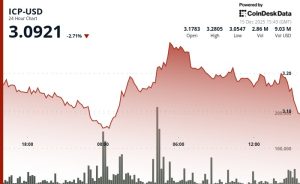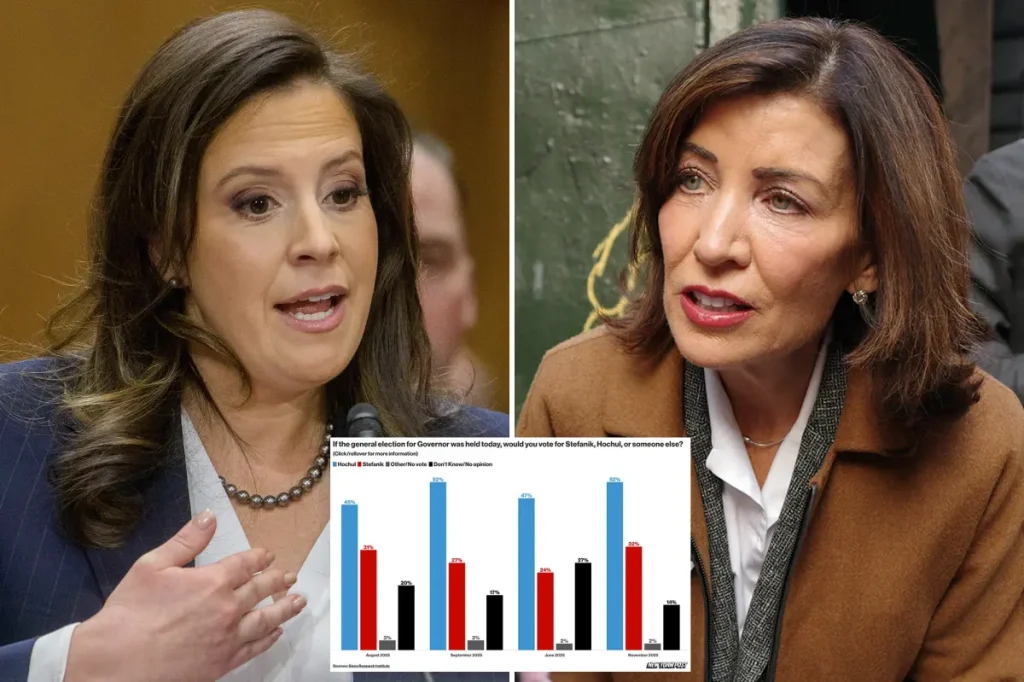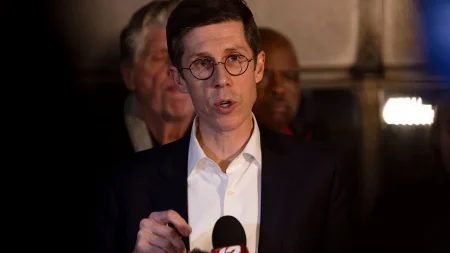Stefanik Gains Ground on Hochul in New York Governor Race
In a political landscape where every percentage point matters, US Representative Elise Stefanik is making notable inroads against incumbent New York Governor Kathy Hochul. The latest Siena University poll, released on Tuesday after surveying over 800 registered New York voters between November 10-12, reveals a shifting dynamic in what promises to be a competitive race for the Empire State’s highest office. While Hochul maintains a lead of 52% to 32% over her Republican challenger, the narrowing gap represents significant movement since September when Stefanik trailed by 25 points. Most telling is Stefanik’s improved standing among independent voters—a crucial bloc in any statewide election—where she now trails Hochul by just four points (40% to 36%), a dramatic improvement from the 18-point deficit she faced just two months earlier. This momentum shift suggests that voters are increasingly open to alternatives as the election approaches, despite New York’s reputation as a Democratic stronghold.
The geographic breakdown of voter support illuminates the challenge both candidates face in appealing beyond their traditional bases. While Hochul enjoys a commanding 42-point advantage in heavily Democratic New York City, her lead shrinks dramatically elsewhere in the state. In the downstate suburban areas—regions that often determine statewide elections—Hochul’s advantage narrows to just nine points. Even more concerning for the incumbent governor, her lead in upstate New York regions has dwindled to a mere three percentage points, territories where Republicans traditionally perform well. This regional disparity highlights the state’s urban-rural divide and suggests that Stefanik’s message may be resonating with voters outside metropolitan areas who feel their concerns have been overlooked by Albany leadership. For Hochul, maintaining her support in these competitive regions will be crucial to securing reelection, while Stefanik’s campaign likely sees these areas as opportunities to build momentum and close the gap further.
The poll reveals deeper concerns for Hochul beyond the head-to-head numbers, particularly regarding her favorability ratings and voters’ overall satisfaction with her leadership. Her favorability stands at just 43%, having slipped two points in recent months—a troubling trend for any incumbent seeking reelection. Perhaps more worrisome, only 42% of voters currently express willingness to reelect Hochul, while a full 48% prefer “someone else” at the helm. Though this represents a slight improvement from September’s 37-51% split, having nearly half of voters actively seeking an alternative presents a significant vulnerability as the campaign intensifies. Among those desiring change, the preference for partisan affiliation is particularly noteworthy: while 30% of dissatisfied voters would prefer another Democrat, a majority—53%—explicitly want a Republican governor. This suggests that voter discontent transcends personality and extends to fundamental policy differences, potentially creating a path for Stefanik to further consolidate opposition to the incumbent.
The partisan dynamics revealed in the poll demonstrate both strengths and evolving challenges for each candidate. Hochul continues to enjoy robust support among Democrats, commanding 78% of her party’s voters compared to just 9% who back Stefanik—relatively unchanged from previous polling. However, Stefanik has strengthened her position among Republicans, with support climbing from 68% to 79% since September, while simultaneously reducing Democrat crossover votes from 15% to 11%. This consolidation of Republican support indicates Stefanik is effectively uniting her party’s base, an essential foundation for any viable statewide campaign in New York. Her improved performance among independents—gaining 11 percentage points while Hochul lost three—further suggests the Republican’s message is finding receptive audiences beyond traditional party lines. For Hochul, the challenge will be maintaining her Democratic coalition while finding ways to appeal to the moderate independents who appear to be drifting toward her opponent.
The shifting electoral landscape comes as the Republican field may become more complicated with Nassau County Executive Bruce Blakeman reportedly preparing to enter the race, though the Siena poll did not include him as a potential candidate. Blakeman’s entry could either split the Republican vote in a primary scenario or introduce new dynamics into the general election conversation. For Stefanik, who has built national recognition as a staunch defender of former President Trump and recently ascended to the role of Chair of the House Republican Conference, maintaining her momentum while potentially navigating intra-party competition presents both opportunity and challenge. Her rising profile has clearly contributed to her improved polling position, but the question remains whether she can continue to broaden her appeal beyond the Republican base to the moderate voters necessary to win statewide in New York. Meanwhile, Hochul—who assumed the governorship following Andrew Cuomo’s resignation before winning election in her own right—must demonstrate to voters that her administration deserves another full term despite the evident voter restlessness.
The emerging contours of this gubernatorial contest reflect broader national political trends where Republicans have been gaining ground even in traditionally Democratic states. While New York remains a Democratic-leaning state that hasn’t elected a Republican governor since George Pataki’s final victory in 2002, the narrowing gap suggests a competitive race ahead that neither side can take for granted. For Hochul, the challenge will be addressing the sources of voter dissatisfaction while reminding New Yorkers of her accomplishments in office. For Stefanik, capitalizing on her momentum while expanding her appeal beyond traditional Republican constituencies will be essential to transforming a tightening race into a genuine opportunity for victory. With approximately a year until the 2024 election, both campaigns will be closely studying these polling trends as they craft their messages and strategies for what promises to be one of the most closely watched gubernatorial contests in the nation. The question remains whether Stefanik’s current momentum represents a temporary fluctuation or the beginning of a fundamental shift in New York’s political landscape.











